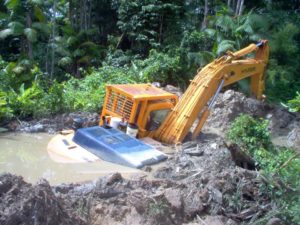
Recently I read a post on LinkedIn where somebody was asking what key metrics companies are looking for in order to develop (or provide financing to) a new mining project. It’s more than just a project having a good NPV or IRR. They are also looking at how difficult it is to achieve the targeted NPV.
 Mining companies are always on the hunt for new projects to grow their cashflows. They would all like to find the “perfect” project; one with ideal conditions and great attributes.
Mining companies are always on the hunt for new projects to grow their cashflows. They would all like to find the “perfect” project; one with ideal conditions and great attributes.
However those perfect projects likely don’t exist anymore, if they ever even did.
Consequently companies must be willing to accept some potential flaws (or risks) in their go-forward projects.
The question is what flaws are they willing to accept and how far away from the ideal situation are they willing to go.
What makes a perfect project?
If one could envision a perfect mining project, what might it look like? Here are some attributes that one would want to see (in random order). If a project had 100% of these, it would be a fantastic project.
-
-
A high grade ore orebody
-
A large reserve and long mine life to ride out commodity price cycles
-
Low operating cost
-
Low cash cost, in the bottom quartile of costs
-
Well defined ore zones, allowing simple mining with low dilution
-
A geotechnically competent rock mass
-
Clean and straightforward metallurgy
-
Consistent and straightforward permitting regulations
-
A stable government and stable fiscal regime
-
Safe security conditions for site personnel
-
High NPV and high IRR
-
No acid runoff issues from waste products
-
Stable tailings disposal conditions
-
Readily available local workforce / local power supply / good water supply
-
Favorable local community and stakeholder support
-
Other readers may have more attributes that they would like to see if asked to theorize “What constitutes a perfect mining project?”
Take off the promoter hat
 Now take an honest look at some recent (or past) projects that you have been involved with. How many of the perfect attributes listed above would be represented? It would be surprising to see them all checked off. Unfortunately that means certain flaws (risks) must be accepted when developing a project.
Now take an honest look at some recent (or past) projects that you have been involved with. How many of the perfect attributes listed above would be represented? It would be surprising to see them all checked off. Unfortunately that means certain flaws (risks) must be accepted when developing a project.
Each company (or financier) will have their vision as to which attributes are “must have” and which ones are “nice to have”.
But we have risk tools
There are many risk tools available to help in evaluating the potential flaws in a project. Unfortunately these tools don’t make the decisions for management.
Risk based Monte Carlo analysis requires management to pre-define the magnitude of the risks and then decide upon what probability of success is acceptable. Real option analysis or decision trees or Kepner-Tregoe are examples of other tools that can help in the decision making process.
Ultimately risk is risky. Management must make the go/no-go decision regardless of how many probabilistic histograms and tables they have generated. A 90% chance of success still means there is a 10% chance of failure. The probability of failure may be low, but it is not zero.
It would be interesting to examine recent failed projects to define the cause(s) of failure. One could then see if the cause was something that was pre-determined as a risk, either as a small risk or a large risk. Perhaps the cause was something that management felt could be mitigated or perhaps it was something viewed as highly unlikely. No doubt that successful projects also had risks, which were either mitigated or which (luckily) never occurred.
Conclusion


 The bottom line is that management understandably have a difficult task in making go/no-go decisions. Financial institutions have similar dilemmas when deciding on whether or not to finance a project.
The bottom line is that management understandably have a difficult task in making go/no-go decisions. Financial institutions have similar dilemmas when deciding on whether or not to finance a project.
Well done Ken.
I’ve always felt the biggest risk in any project is the resource model. Almost all projects miss on capital and operating costs but manage to survive despite these issues. Throughput and recovery problems can be fixed, albeit at considerable extra expense. But once the metal is placed in the ground no one can add to or subtract from it. I’ve seen several projects go South because of inaccurate resource estimates…both tonnes and grade. There is no fix for that so it needs to be an accurate representation of reality to make a project successful.
Not mentioned is availability of water. This is becoming an important issue in some countries, although not so much in Canada.
Another survival issue is whether a mine can generate enough cash to pay the bills and also pay interest on debt. I’ve seen several situations where mines could pay the bills but could not make debt and interest payments.
Good points. Projects that don’t have a certainty in cashflow may be due to various reasons (grade, recovery, etc). A decrease in metal price is not a part of the project itself, however if the grades or costs are marginal then it cannot tolerate a price decrease. That’s one of the risks that some projects must either live with or not be put into production.
I do mention water supply in the second to last bullet, along with power and labour.